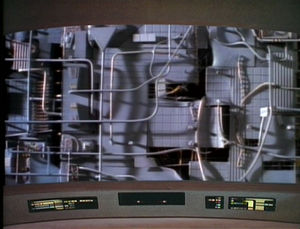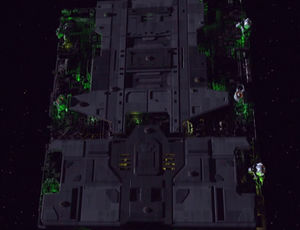Difference between revisions of "Borg adaptation"
| Line 16: | Line 16: | ||
=== Adaptation versus Projectile Weapons === | === Adaptation versus Projectile Weapons === | ||
In ''Star Trek: First Contact'', Captain Picard fires a Thompson submachine gun at two Borg drones. The drones do not adapt and are killed. The Borg possibly "adapt" to projectile-weapon species with armored tactical drones and tactical cubes<ref>[[VOY]] "Dark Frontier" and "Unimatrix Zero"</ref>. However, no evidence indicates Borg drone shields are effective against kinetic penetrators. | In ''Star Trek: First Contact'', Captain Picard fires a holographic Thompson submachine gun at two Borg drones. The drones do not adapt and are killed. The Borg possibly "adapt" to projectile-weapon species with armored tactical drones and tactical cubes<ref>[[VOY]] "Dark Frontier" and "Unimatrix Zero"</ref>. However, no evidence indicates Borg drone shields are effective against kinetic penetrators. | ||
==References== | ==References== | ||
Revision as of 17:20, 25 March 2010
Adaptations are a variety of mechanisms by which the Borg defend themselves from threats.
Adaptation Methods
Shields
Adaptation is generally referred to in the context of shields. Both drones and cubes can protect themselves from energy weapons with shields. The Borg adapt their shields to provide defense against phasers and other energy weapons. Specifically, the Borg identify the operating frequency of the beams used against them and screen against that frequency. Drones can prevent any damage from a hand-phaser, and cubes can repel the full power of a Galaxy-class starship. This makes the Borg highly resistant to the weapons of most powers in the Milky Way.
Shield adaptation will not negate an unlimited amount of firepower. With a sufficient number of attacking ships, Borg cubes can still be damaged despite their defensive adaptations.[1] Borg defenses often have little effect on weapons they have not previously encountered during initial attacks, but they typically develop defensive adaptations within a few attacks.
Frequencies
The most common examples of adaptation in Star Trek involve frequency-based weapons. Frequency-based weapons such as phasers become ineffective after the Borg have adapted. In combat, Federation starships rapidly change the frequency of their weapons to hinder adaptation. However, rapidly rotating frequencies is, at best, a delaying tactic. Federation hand phasers can also be programmed to rapidly change frequencies, allowing a security officer to disable or kill several drones before the Borg adapt and render his weapon useless.
Repair
Adaptation also appears as a formidable self-repair mechanism[2]. After being hit by phaser fire, the Borg Cube repairs itself. The cube's outer hull is constructed of ductile material conducive to self-repair. It is unclear whether all Borg cubes possess this ability. Other Borg cubes have not shown this ability for rapid repair.
Adaptation versus Projectile Weapons
In Star Trek: First Contact, Captain Picard fires a holographic Thompson submachine gun at two Borg drones. The drones do not adapt and are killed. The Borg possibly "adapt" to projectile-weapon species with armored tactical drones and tactical cubes[3]. However, no evidence indicates Borg drone shields are effective against kinetic penetrators.



